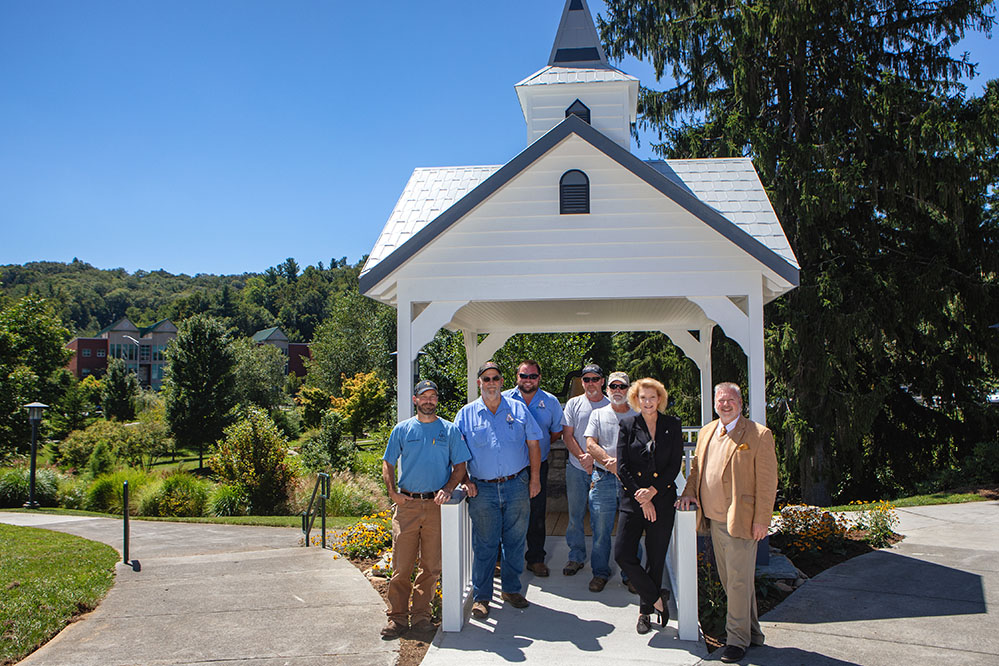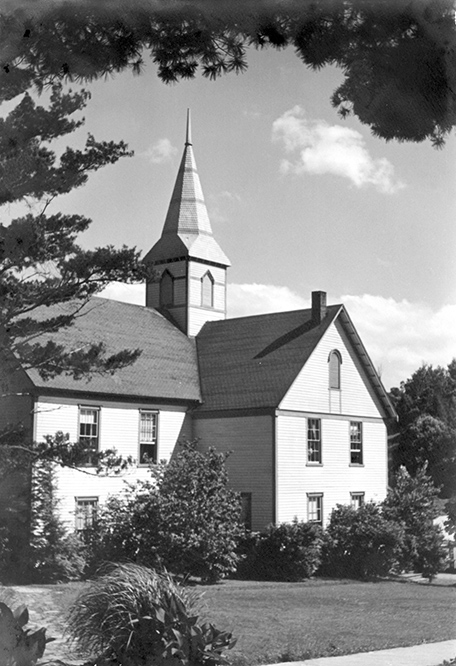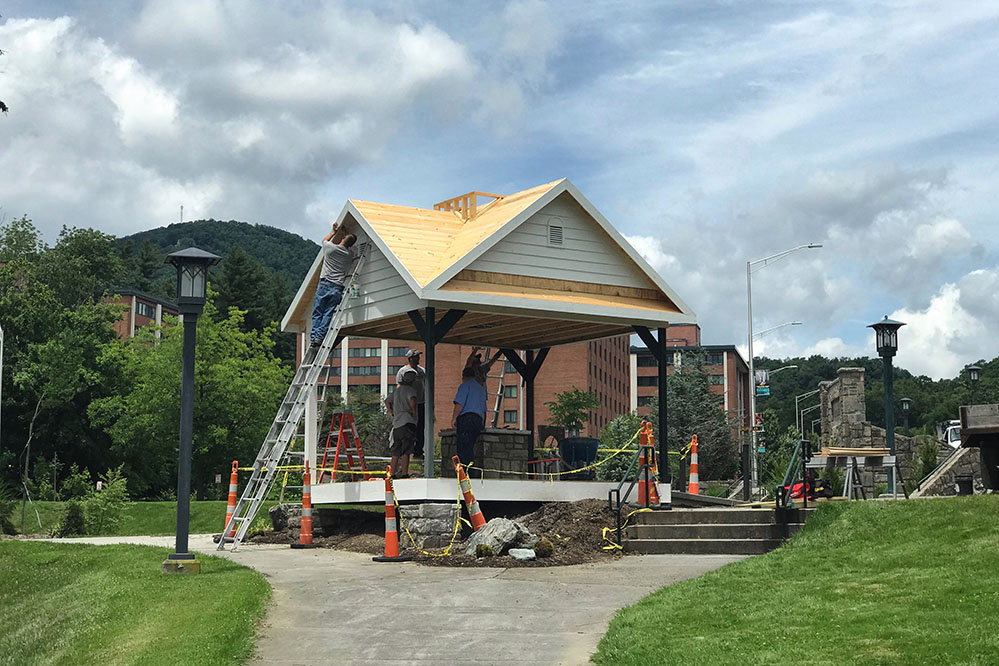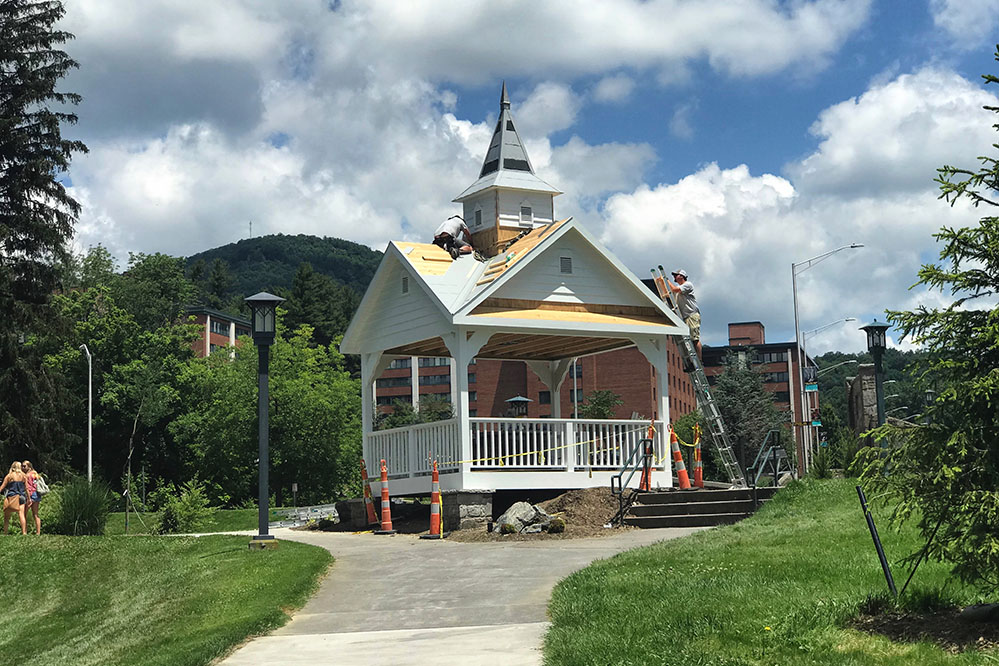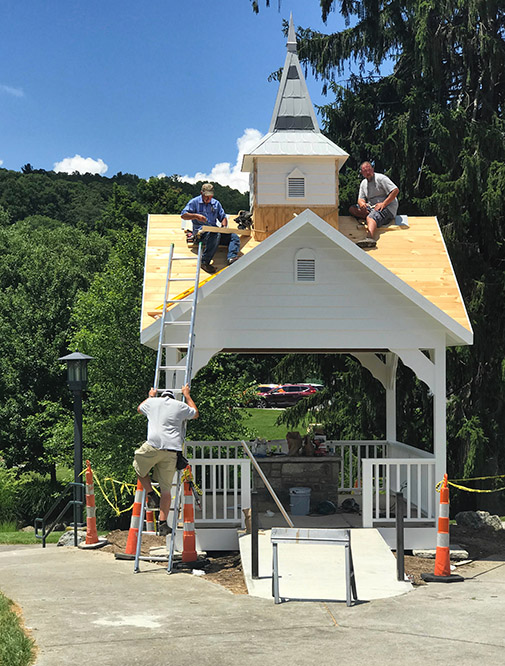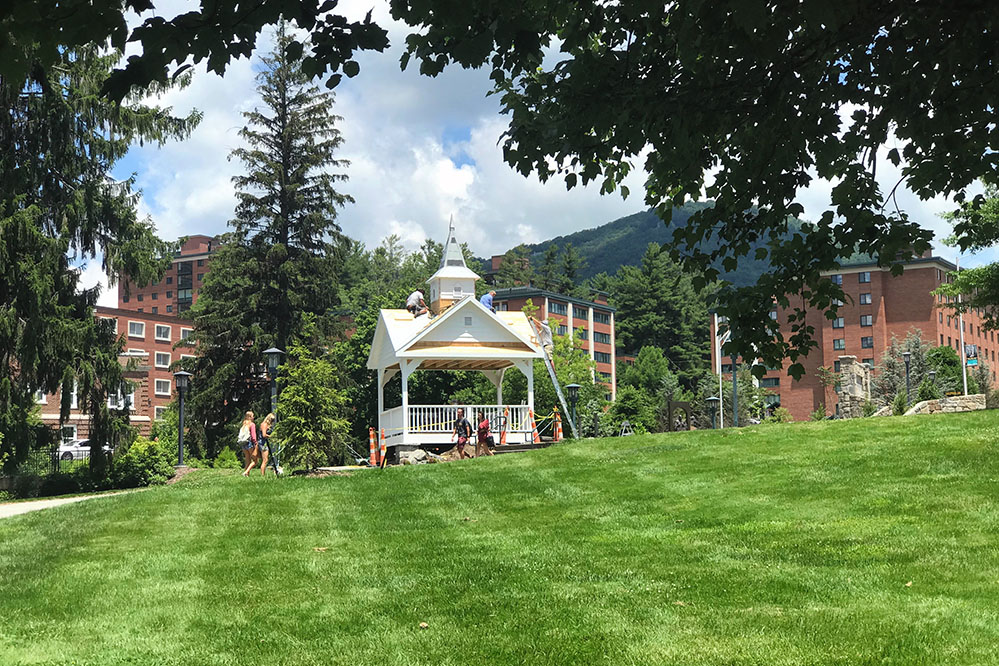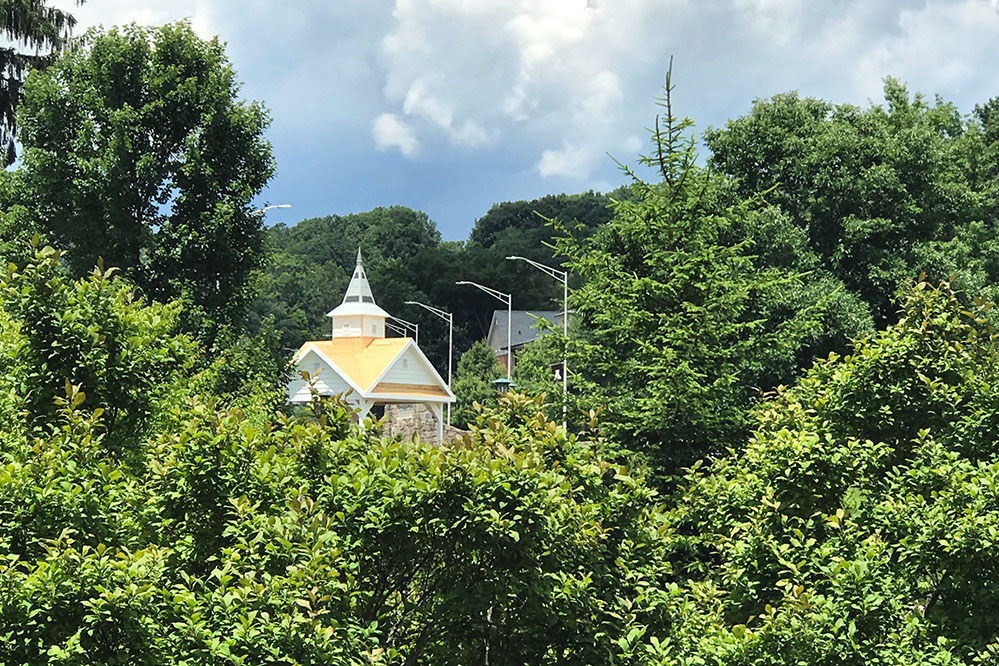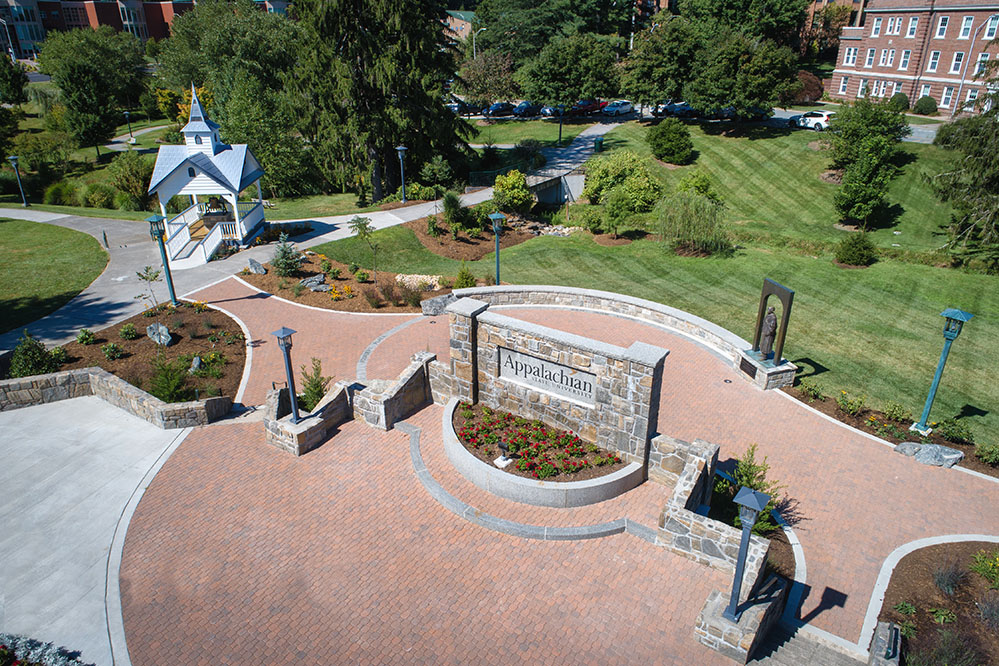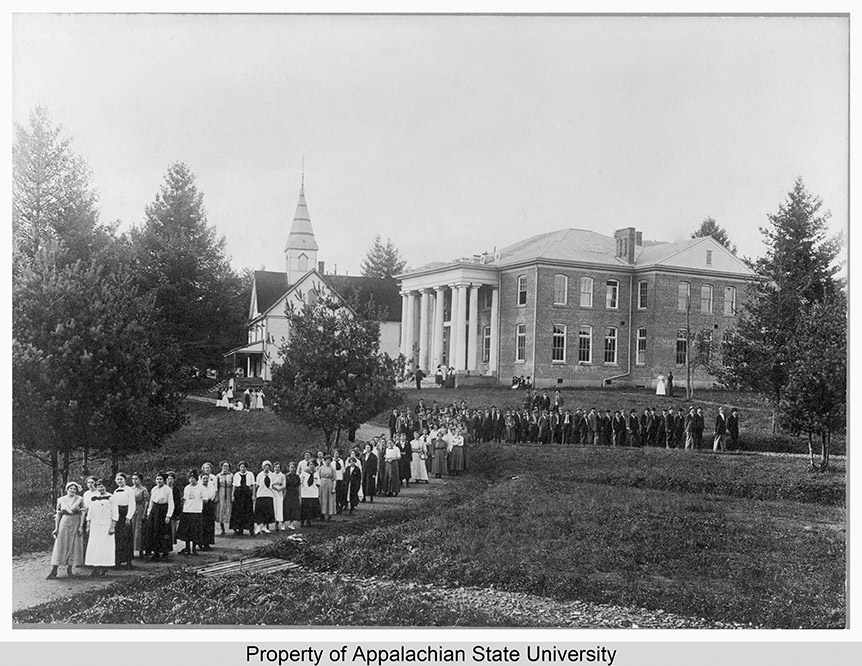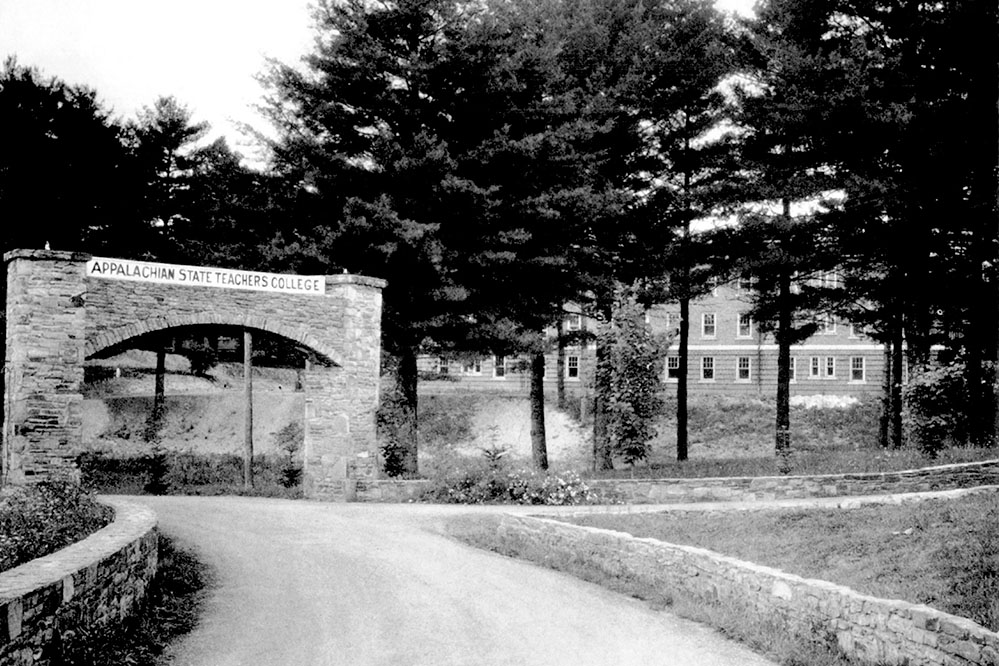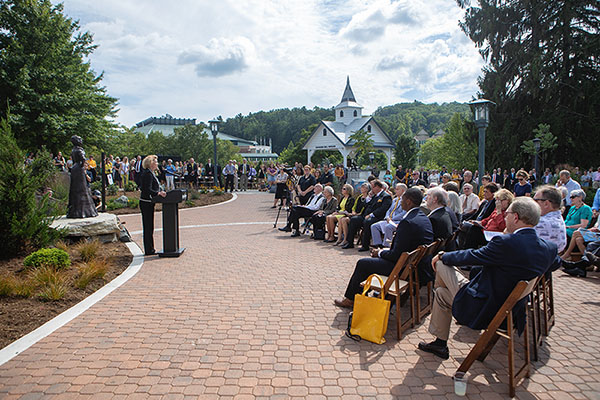BOONE, N.C. — Skilled workers in Appalachian State University’s Physical Plant have recreated a piece of history in Founders Plaza, just in time for Founders Day.
Founders Bell Pavilion, constructed in July, is a reproduction of the characteristic roofline of Watauga Academy, the school founded in 1899 that would later become Appalachian State University. The pavilion contains the Founders Bell, a representation of the first bell that called young people to education at the school founded by brothers B.B. and D.D. Dougherty and D.D.’s wife, Lillie Shull Dougherty.
The pavilion is among the latest additions to Founders Plaza, located at the campus entrance near Hardin Street.
Members of the university’s Physical Plant — many of whom have remodeled local homes from the turn of the 20th century and thus have practical experience with construction of that era — designed and built the pavilion as part of Chancellor Sheri Everts’ initiative to capture and celebrate the history and traditions of the university.
“I am deeply grateful for the beautiful work of those who designed and built Founders Bell Pavilion: carpenters Wayne Hicks, Ricky Jones, David Warren, Shady Shepherd, Benjamin Gragg and Steve Swanson, and the many other individuals from the Physical Plant’s landscaping, masonry, electrical, mechanical and paint shops who worked to complete this project,” Everts said.
“Founders Plaza is a touchstone to our history and a gateway to campus, as it is located where the original stone arch entry to campus was in the early days of the school. The plaza offers a gathering place where the Appalachian Community can engage with the history of our university and its three founders. The Founders Bell Pavilion is one more way we are working to tell a fuller history of Appalachian — and of those who helped make it the institution it is today.”
Wayne Hicks, carpentry shop supervisor, said his team “enjoyed the heck out of this project.”
“What all the carpenters really liked about the job was that they got to showcase true carpentry skills. Old-fashioned carpentry skills. Not just in creating the design, but in the physical work of putting all the angles on the rooflines and installing the metal shingles and building the cupola.
“It all involved skills that we don’t get to use much, but really enjoy,” Hicks continued. “There are a lot of carpenters that couldn’t have pulled this off. We’ve got some great carpenters on staff.”
The original Watauga Academy
The two-story, white frame Watauga Academy stood in a grove of white pine trees, near where Sanford Hall is now. It was crowned with a gabled roof and bell steeple.
According to University Archives, townspeople raised $1,100 to construct the Watauga Academy, after a borrowed building with broken windows and no door proved inadequate for the new school being formed by the Doughertys.
Watauga Academy opened in January 1900, unfinished, to 150 students. It was completed in 1903 and served as the school’s only building until 1905. It burned in 1946.
The bell
Watauga Academy’s original steel bell survived the 1946 fire and is displayed in the B.B. Dougherty Administration Building. The gold-painted steel bell inside Founders Bell Pavilion is also part of Appalachian’s history.
The bell was forged in 1924, as evidenced by the date stamped in its interior, and is believed to be the “spirit” or “victory” bell that students rang outside the gymnasium after athletic wins in the 1930s to 1960s.
The university displayed the bell on a short pedestal behind I.G. Greer Hall for many years. It had a sizeable chip at its edge. In preparation for the university’s centennial celebration in 1999, the chip was repaired and the bell was renamed Founder’s Bell before being moved to a stone block at the entrance of Anne Belk Hall, which at the time was the main library. The bell remained there for 20 years.
This summer, members of the Physical Plant took the bell to Lower Bells, a company near Knoxville, Tennessee, for repairs, including new supports and a replacement clapper. The clapper, which will be attached only for the annual Founders Day celebration Sept. 5, dates to the 1870s. Other parts of the bell installation are original.
Beginning this year, the university plans to have members of the new Bell Ringers Society ring the bell at each Founders Day — once for each year of Appalachian’s existence.
The pavilion
Hank Foreman, vice chancellor and chief of staff for Chancellor Everts, has taken a lead role in developing Founders Plaza and its components that strengthen visible ties to Appalachian’s history.
“We needed a home for the bell and wondered, ‘How do we harken back to that time period?’ It is through Watauga Academy,” Foreman said. He showed photographs of the original school to Hicks, and Hicks and his staff started working on designs to mirror the original architecture of Watauga Academy.
Features incorporated from 1899 include metal shingles and louvers for ventilating the bell steeple and emitting the original bell’s tone.
Some materials used during that time are no longer available, so the carpenters used what they could replicate most closely. The pavilion is made of cedar, while Watauga Academy was likely made of heart pine — boards B.B. and D.D. Dougherty are said to have helped haul from the sawmill themselves.
Construction specifications include:
- Size: approximately 168 square feet.
- Roof material: metal shingle.
- Floor construction: treated wood.
- Exterior rail: wood (cedar).
- Exterior post: steel encased in cedar.
- Date of completion: Aug. 1, 2019.
“The Physical Plant did an amazing job,” Foreman said of the team’s work. “We now have a great place for students and their families to gather for photographs — a literal gathering place that is connected to our past.”
Foreman continued, “Not only is the pavilion a testament to the work of our founders, but like so many other areas of beauty and reflection on our campus, it is also a monument to the people who have dedicated their lives to this special place.”
What do you think?
Share your feedback on this story.
About Founders Day
Appalachian State University celebrates Founders Day on Sept. 5 to honor the university’s founders — B.B. Dougherty, D.D. Dougherty and Lillie Shull Dougherty — and the first day of classes at Watauga Academy in 1899. Appalachian began this annual tradition in 2018 with the dedication of Founders Plaza, a touchstone to the university’s early days that is located at the campus entrance on Hardin Street.
About Appalachian State University
As a premier public institution, Appalachian State University prepares students to lead purposeful lives. App State is one of 17 campuses in the University of North Carolina System, with a national reputation for innovative teaching and opening access to a high-quality, cost-effective education. The university enrolls more than 21,000 students, has a low student-to-faculty ratio and offers more than 150 undergraduate and 80 graduate majors at its Boone and Hickory campuses and through App State Online. Learn more at https://www.appstate.edu.

